There’s much more than explosive ending to Lab Theater’s ‘I and You’
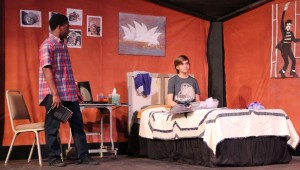 In Wings, Lab Theater took its audiences into the mind and body of an aerial acrobat who suffers a massive stroke in the play’s opening moments. With Lauren Gunderson’s I and You, The Lab now immerses us in the psyche of a teenage girl in the end stages of genetic liver disease facing imminent death unless a donor can be found.
In Wings, Lab Theater took its audiences into the mind and body of an aerial acrobat who suffers a massive stroke in the play’s opening moments. With Lauren Gunderson’s I and You, The Lab now immerses us in the psyche of a teenage girl in the end stages of genetic liver disease facing imminent death unless a donor can be found.
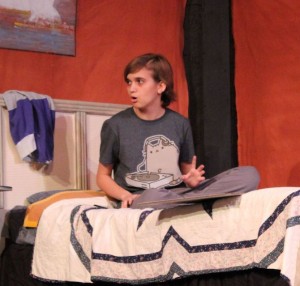 The underlying premise of this brisk 80-minute tw0-actor play places a heavy demand on Eren Sisk and Mike Edouard. For Sisk’s part, she must fathom the mindset and psychological defenses of a girl who’s been afflicted her entire life by a debilitating disease that provokes sympathy, pity and feigned civility from everyone she encounters. Edouard’s unenviable task is to figure out how to relate to someone who is dying and circumvent the inevitable defenses they erect in the often-futile attempt to preserve some semblance of normalcy
The underlying premise of this brisk 80-minute tw0-actor play places a heavy demand on Eren Sisk and Mike Edouard. For Sisk’s part, she must fathom the mindset and psychological defenses of a girl who’s been afflicted her entire life by a debilitating disease that provokes sympathy, pity and feigned civility from everyone she encounters. Edouard’s unenviable task is to figure out how to relate to someone who is dying and circumvent the inevitable defenses they erect in the often-futile attempt to preserve some semblance of normalcy 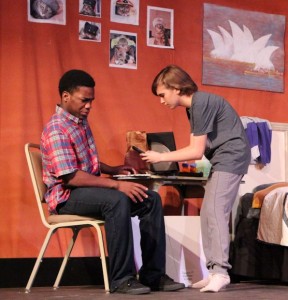 in a universe of barbaric yawp.
in a universe of barbaric yawp.
Sisk and Edouard are Fort Myers High juniors. Both profess to know people who’ve battled life-threatening illnesses, but those experiences offered little insight into their characters. That’s for the best. They approach their roles with a purity that’s unencumbered by preconceived notions of what it is like to be ill or to deal with someone who faces their mortality moment by moment. They take what the playwright and director Lauren Redeker give them and bring their characters to life with an honesty and 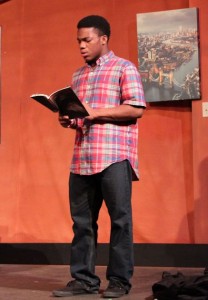 freshness that transcends the age, gender and demographic divide.
freshness that transcends the age, gender and demographic divide.
Caroline is a romantic 17-year-old who’s been sick as long as she can remember. But in her all-important senior year of high school, her condition has taken a nasty turn for the worst, imprisoning her in her room and forcing her to attend classes via Skype and the internet. She’s turned into a hard case. No doubt, she has lots of cause for resentment. She can’t be with her friends. Dating is out of the question. Her dad left her mom because he could no longer deal with Christine’s illness. But what she hates most is pity – people being nice for no good reason other than that she’s so sick. As a result, she’s developed a surly, prickly, crusty shell designed to ward off the good 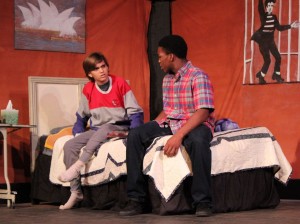 intentions of misguided well-wishers. Not surprisingly, her favorite stuffed animal is a hard-shelled snapping turtle.
intentions of misguided well-wishers. Not surprisingly, her favorite stuffed animal is a hard-shelled snapping turtle.
By contrast, Anthony is smart, athletic and endearingly geeky. He loves poetry and idolizes Walt Whitman. You won’t find Drake, Kayne or Fetty Wap on Anthony’s ipod playlist. No, he’s an inveterate fan of Coltrane and Thelonius Monk. 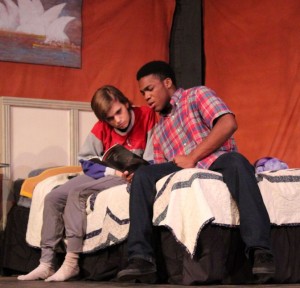 But when he arrives unannounced in Caroline’s bedroom to collaborate on an English project due the next day, the two begin a charming approach-avoidance dance that keeps the poor, well-meaning lad off-balance, confused and completely befuddled.
But when he arrives unannounced in Caroline’s bedroom to collaborate on an English project due the next day, the two begin a charming approach-avoidance dance that keeps the poor, well-meaning lad off-balance, confused and completely befuddled.
Admittedly, the plot suffers from a handful of anomalies. For example, why would over-achieving, straight-A Anthony wait to the last minute to collaborate with Christine on the all-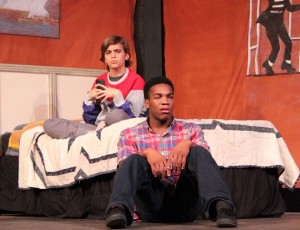 important Walt Whitman “Leaves of Autumn” project? And why wouldn’t she know in advance that she’d been assigned to work with him on it? Don’t worry. All will be explained in the end.
important Walt Whitman “Leaves of Autumn” project? And why wouldn’t she know in advance that she’d been assigned to work with him on it? Don’t worry. All will be explained in the end.
More problematic is the dialogue that passes between the two teens.
Sisk and Edouard are too polite to quibble with the words that Gunderson gives them. But in the 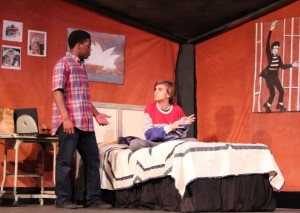 playwright’s defense, it was not her intent to recreate the exact verbiage, lingo and idioms popular with today’s teens or Millennials. After all, they are not her target audience. Gunderson is using teenage characters to highlight a problem faced by growing numbers of theater-going Gen-X and Baby Boomers, namely how to relate to someone experiencing a serious, life-threatening or
playwright’s defense, it was not her intent to recreate the exact verbiage, lingo and idioms popular with today’s teens or Millennials. After all, they are not her target audience. Gunderson is using teenage characters to highlight a problem faced by growing numbers of theater-going Gen-X and Baby Boomers, namely how to relate to someone experiencing a serious, life-threatening or 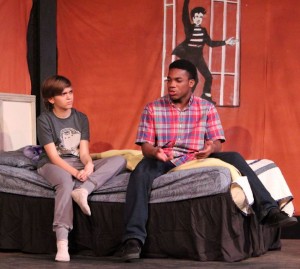 terminal illness. Employing characters in their 50s, 60s or 70s would have been far too dreary and ponderous, but cost of going for a more youthful, positive and upbeat approach was the need to craft a dialogue that approximates teen-talk without losing or alienating the older demographic that typically patronizes theater productions.
terminal illness. Employing characters in their 50s, 60s or 70s would have been far too dreary and ponderous, but cost of going for a more youthful, positive and upbeat approach was the need to craft a dialogue that approximates teen-talk without losing or alienating the older demographic that typically patronizes theater productions.
Although there are some clunky lines and unrealistic sequences, Gunderson succeeds in delivering a package that underscores a theme worth 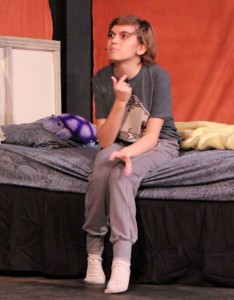 pondering in the days and weeks following the play’s denouement. And that makes “I and You” worth seeing no matter your age. Of course, it doesn’t hurt that “I and You” has an explosive ending that will leave you reeling. But when the commotion dies down, what you will remember about this production are the efforts of one young woman to retain dignity and authenticity in spite of her terminal condition and the efforts of one young friend to relate to her as a person rather than as a patient. And for that, we can thank Redeker, Sisk and Edouard.
pondering in the days and weeks following the play’s denouement. And that makes “I and You” worth seeing no matter your age. Of course, it doesn’t hurt that “I and You” has an explosive ending that will leave you reeling. But when the commotion dies down, what you will remember about this production are the efforts of one young woman to retain dignity and authenticity in spite of her terminal condition and the efforts of one young friend to relate to her as a person rather than as a patient. And for that, we can thank Redeker, Sisk and Edouard.
December 8, 2016













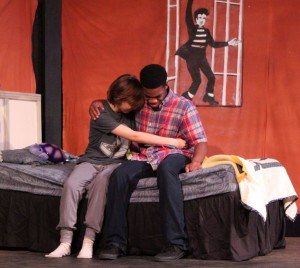

 Tom Hall is both an amateur artist and aspiring novelist who writes art quest thrillers. He is in the final stages of completing his debut novel titled "Art Detective," a story that fictionalizes the discovery of the fabled billion-dollar Impressionist collection of Parisian art dealer Josse Bernheim-Jeune, thought by many to have perished during World War II when the collection's hiding place, Castle de Rastignac in southern France, was destroyed by the Wehrmacht in reprisal for attacks made by members of the Resistance operating in the area. A former tax attorney, Tom holds a bachelor's degree as well as both a juris doctorate and masters of laws in taxation from the University of Florida. Tom lives in Estero, Florida with his fiancee, Connie, and their four cats.
Tom Hall is both an amateur artist and aspiring novelist who writes art quest thrillers. He is in the final stages of completing his debut novel titled "Art Detective," a story that fictionalizes the discovery of the fabled billion-dollar Impressionist collection of Parisian art dealer Josse Bernheim-Jeune, thought by many to have perished during World War II when the collection's hiding place, Castle de Rastignac in southern France, was destroyed by the Wehrmacht in reprisal for attacks made by members of the Resistance operating in the area. A former tax attorney, Tom holds a bachelor's degree as well as both a juris doctorate and masters of laws in taxation from the University of Florida. Tom lives in Estero, Florida with his fiancee, Connie, and their four cats.